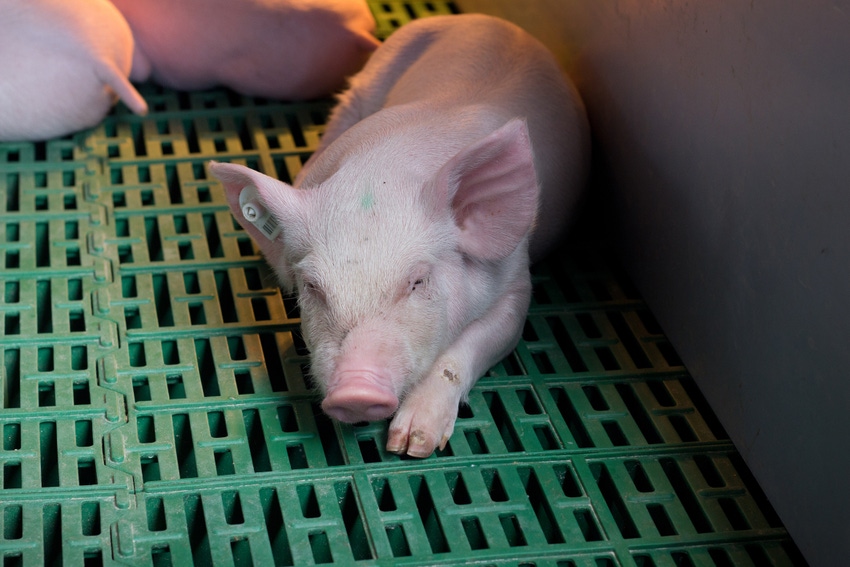Proposed research could lead to increased sensitivity of PCR testing for domestic and foreign animal diseases affecting swine.
July 30, 2020

Recent unpublished, observational research indicates that oral fluids — when collected by rope as an aggregate sample — could be a good sample for the rapid detection of African swine fever virus (ASFV), according to a news item posted on the American Association of Swine Veterinarians website by the Swine Health Information Center (SHIC).
However, SHIC said this experimental research also suggests that there is potential for false-negative test results. Therefore, SHIC is calling for proposals to develop methods to improve the detection of low levels of nucleic acid in oral fluids through enhancements to sample pre-extraction treatment(s) or through improved extraction methodologies compatible with the high-throughput testing currently done in National Animal Health Laboratory Network (NAHLN) laboratories.
SHIC executive director Paul Sundberg said with thousands of oral fluid samples coming into diagnostic labs each month, the value of this type of testing for swine disease monitoring is irrefutable.
The objective of this SHIC-funded research is to address concerns about oral fluid testing sensitivity, he said, adding that this knowledge opens the potential for an official option for ASFV testing beyond whole blood, which is the antemortem sample presently proposed by the U.S. Department of Agriculture for surveillance.
Due to the urgency of preparing testing protocols for ASFV and other foreign animal diseases, SHIC will favor proposals reflecting this immediate need.
In a negative cohort study, no false positives for ASFV were reported. The experimental, unpublished, observational work indicated that ASFV may be detected in oral fluids prior to the onset of clinical signs, even if only a small proportion of animals are infected, SHIC noted. However, it added, because the viral load was much lower in oral fluids than in individual tissue samples, the study indicated that false negatives do occur.
According to the SHIC post, this limits the potential use of swine oral fluids as an official monitoring and surveillance tool in the event of an African swine fever outbreak in the U.S. without further study and refinement.
SHIC noted that oral fluid samples are widely used on U.S. swine farms in surveillance for porcine reproductive and respiratory syndrome virus (PRRSV), influenza A virus in swine (IAV-S) and Mycoplasma hyopneumoniae (MHP) nucleic acids and have shown the potential for use in foreign animal disease surveillance as well. To date, more than 27 pig pathogens have been shown to produce detectable levels of nucleic acid in oral fluids.
The proposed research could lead to increased sensitivity of polymerase chain reaction (PCR) testing for these domestic and foreign animal diseases, SHIC said.
SHIC noted that it is also currently sponsoring oral fluid sensitivity research in Vietnam related to ASFV and hopes that the research related to this new request for proposals will result in methods sensitive enough to support oral fluid PCR diagnostic validation.
SHIC listed the following detailed points that are included in its request for proposals:
The objective of the research is to identify sample treatments (for example, centrifugation, nucleic acid concentration or other sample treatments) or extraction methods that improve the quantitative detection of PRRSV, IAV-S and MHP nucleic acids in swine oral fluids.
The research should include comparisons of the proposed sample treatments or extraction methods with the high-throughput protocols currently in use in NAHLN veterinary diagnostic laboratories.
The proposal should include a clear description of the experimental design and statistical methods to be used in data analyses and provide for enough replicates and statistical power to be able to clearly show if the probability of detection by concentration differs among treatments or extraction methodologies for a particular PCR test.
Since research has shown that it is easier to recover nucleic acids from intentionally spiked samples than from samples collected from infected pigs, the experimental design should include oral fluid samples collected from infected pigs. Proposals that leverage partnerships with pork producers and their veterinarians to use samples from naturally infected pigs, i.e., control costs, will be prioritized.
With the importance of improving swine oral fluid PCR sensitivity so it can be used with confidence as an official monitoring and surveillance tool, proposals with a timeline reflecting that urgency will also be prioritized.
The deadline for submitting a request for proposal to SHIC for this project is at 5 p.m. (CDT) Aug. 25, 2020. For more information on the process, contact Sundberg at [email protected].
As the world deals with the COVID-19 pandemic, SHIC said it continues to focus efforts on prevention, preparedness and response to novel and emerging swine disease for the benefit of U.S. swine health. As a conduit of information and research, SHIC encourages the sharing of its publications and research. SHIC is funded by America's pork producers to fulfill its mission to protect and enhance the health of the U.S. swine herd.
You May Also Like

.png?width=300&auto=webp&quality=80&disable=upscale)

